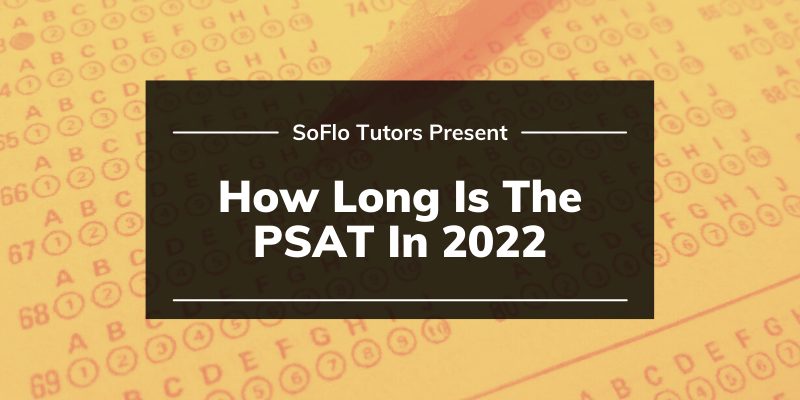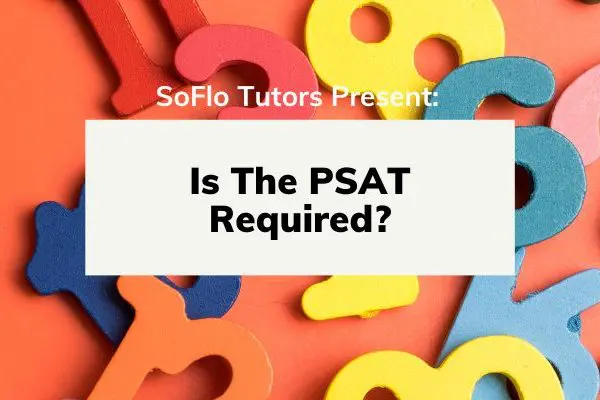
For most 10th and 11th grade students across the nation, there is a school day dedicated to taking the PSAT. Students can take the test once per year and it is an important preparation step to eventually taking the SAT. Read on to find out how long the PSAT takes, and important information you should know about the test structure and time accommodations for those who need it.
What Is PSAT And How Is It Structured
The Preliminary SAT, also known as the PSAT, is a standardized test primarily given to high school students and, as mentioned above, is a preparation tool for the SAT exam. Eleventh graders taking the PSAT have the opportunity to win scholarships through the National Merit Scholarship Program. As such, the test is also known as the National Merit Scholarship Qualifying Test (NMSQT).
The PSAT is similarly structured to the SAT so students can get a feel for the test format and types of questions it will ask, but they are not exactly the same. Like the SAT, the PSAT is divided into four sections that will test you on different subjects and skills. The sections are: Writing and Language, Reading, Math with a calculator, and Math without a calculator. All four sections ask questions in a multiple-choice format, where you will be given four choices of answers, and has some short answer grid-in questions.
One difference between the PSAT and SAT is the question content. Because the PSAT is catered towards students in the 11th grade and younger, the questions are adjusted for grade level and a bit easier than those found in the SAT. Another difference is the scoring scale—while the SAT score ranges from 400 to 1600, the score range for the PSAT is 320 and 1520. Finally, a major difference between the two tests is the time limits for each section and the overall time it takes to take the exam. Overall, the SAT is about 15 minutes longer than the PSAT.
PSAT Time Breakdown For Each Section
Each section is allotted a difference amount of time for you to complete. While you can go back and review any question in the section within the time limit, you cannot go back to past sections or start working on future sections. It is important to know the time limits of each section so you can accurately pace yourself during the exam—the last thing you want to do is run out of time!
Writing And Language
In the Writing and Language section, you’ll be editing passages that contain deliberate errors. You will be asked fix these errors, including correcting grammar, word choice, and editing the passage for clarity. The passages cover topics in humanities, social studies, history, or science and their complexity will vary. They are 400-450 words in length and some contain accompanying charts, graphs, and infographics that you must interpret. To succeed in this section, you will have to have an eye for detail, a good understanding of basic English grammar rules, and a sense for narrative/article structure.
In the Writing and Language section, you must answer 44 questions under a 35 minute time limit. This means you have about 45 seconds to answer each question.
Reading
In the Reading section, you’ll be reading five passages and answering questions about their content. Each passage is about 500-750 words and some will have an accompanying chart, graph, or infographic. The passages will be on the following topics:
- One passage from a work of U.S. or global fiction, either classic or contemporary.
- One passage from the social sciences, such as economics, psychology, or sociology.
- One passage or pair of shorter passages from a U.S. founding document, such as the Declaration of Independence, or a text in the Great Global Conversation they inspired. Great Global Conversation means texts that have themes of freedom, justice, or human dignity, such as a speech by Nelson Mandela.
- Two passages from scientific works that examine foundational concepts and developments in Earth science, biology, chemistry, or physics.
In the Reading section, you must answer 47 questions under a 60 minute time limit. This means you have about 12 minutes to answer questions in each passage.
Math
In the Math section, you’ll be given math problems that cover areas important to a variety of situations that will come up in your college major, career, and personal life. There are four main types of math questions in the section:
- Heart of Algebra. This focuses on linear equations and systems.
- Problem Solving and Data Analysis. This focuses on analyzing problems and interpreting information from data.
- Passport to Advanced Math. This focuses on manipulating more complex equations.
- Additional Topics in Math. This focuses on problems related to statistics and probability.
The Math section is divided into two separate sections: one where you are allowed to use a calculator, and one where you are not.
Math No Calculator
In the Math No Calculator section, you are given a total of 17 questions to answer in 25 minutes. Thirteen of these questions are in multiple-choice format, while 4 of them expect you to grid-in the answers.
Math Calculator Allowed
In the Math Calculator section, you are given a total of 31 questions to answer in 45 minutes. Twenty-seven of these questions are in multiple-choice format, while 4 of them expect you to grid-in the answers.
So, How Long Does PSAT Take Overall
In sum, time limits from each section of the PSAT are 35 minutes for Writing, 70 minutes for both Math sections combined, and 60 minutes for Reading. Adding up all these time limits, you get the overall testing time to be 2 hours and 45 minutes, plus breaks.
Extended Time
Some students are eligible to request extended time on the PSAT.
If you believe you are eligible for this, or other accommodations, you must get prior approval from an SSD coordinator, your school, or test center who will most likely request documentation showing that you have a disability and that it specifically makes it a challenge to complete tests under a timed environment.
Some examples of cases where students should request extended time are outlined on the College Board website. Students can request accommodations in specific sections, as well. For example, one students’ disability may affect their performance in the Math section, but not in Reading. In this case, extended time will only be granted for the student’s Math section.
Everything You Need To Know About The Breaks
All of College Board’s exams, including the PSAT, have scheduled breaks. There are usually brief 5-minute breaks between every hour of testing, so under standard conditions, there is one 5-minute break after the first section and one 5-minute break after the third section of the PSAT.
Students who are approved for extended time also receive additional or longer breaks. There are three types of breaks that are commonly requested: breaks as needed, extended breaks, and extra breaks.
Breaks As Needed
Students can ask for a break during the exam at any time, as long as it’s needed. These requests must be within reason.
Extended Breaks
Students are given 10-minute breaks, rather than the 5-minutes under standard conditions.
Extra Breaks
Students are given three additional 5-minute breaks.
PSAT Time Management Tips For The Students
Many students find time management to be one of the most difficult aspects of the PSAT. Even if students know how to solve every Math problem on the test, or can find all the answers in Reading, if they can’t do it within the time limit, it won’t count. Working under the clock can be stressful, and students can find themselves blanking on easy questions or making simple mistakes while rushing through the test. Taking the PSAT, and any other timed test, often requires alternative test-taking strategies and approaches to make sure you complete the test as accurately as possible. Here are some tips if you are studying struggling with time management.
Make Timed Practice Tests Your Habit
Taking timed practice tests is one of the best ways to improve your time management. The more you practice under timed conditions, the more you will get used to the format and the more you can practice time-saving strategies.
If you are the type of student that gets caught up in stressful, timed test conditions, taking multiple timed practice tests will help you become more familiar with navigating this type of environment. You can try out breathing and mindfulness exercises during these low-stakes practice tests and figure out what works for you. Additionally, general familiarity with the format will help mitigate stress are you know what to expect and that you’ve been able to get through it before.
Taking timed practice tests is also important for you to get a general feel for how long you should be spending on each question. Getting used to the time limit gives you a better sense if you’re spending too much time on a challenging question or if you have some space to slow down and be more careful. In general, students should know the general pace of answering questions on each test. For example, if you are halfway through the section time limit, you should generally have answered half of the questions in the section already.
Taking multiple practice tests under the time limit is also an important way to figure out what types of questions or sections slow you down. Some students are slower readers, and some take more time thinking about how to approach math questions. Figuring out your weaknesses early on will be essential to developing a testing strategy that will address this.
Finally, it is also important to do some practice problems under timed pressure, not just full practice tests. Doing these problems under a time limit will train your brain to think quickly and absorb information quicker. Additionally, PSAT questions test the same skills every year. Being able to answer easier questions easily and accurately will save you time to work through the harder questions towards the end.
Start Off With The Questions You Know Answers To
Questions on the PSAT vary in difficulty, but all questions are worth the same amount of points. You don’t want to waste your time on one hard question when you can answer five easy questions in the time amount of time! It is important to know how to identify these harder questions, mark them, and move on to questions that you know the answers to. You can always go back and work on them at the end. Remember that the PSAT will not give any credit to questions left unanswered, and doesn’t penalize incorrect answers. So at least make sure that all your answer bubbles are filled in the moment the proctor calls time on the section!
Skim Through The Passages When You Start
Many students struggle with the Reading section of the PSAT because they are not used to reading under a time pressure. It’s easy to spend too much time reading so that there isn’t enough time to actually answer questions about the passage. Skimming the passages when you begin the Reading section is a good strategy to make sure you don’t get lost in the details. When skimming, you should be keeping in mind the main ideas, characters, and themes. Many students also find annotating helpful to keep track of these things. Skimming is a great strategy to make sure you are only focusing on the important points of the passage that will be relevant to the questions asked afterwards.
Start Preparing For The Tests Today With SoFlo
If you are looking for help with time management on the PSAT, or general help with standardized test studying, SoFlo Tutoring is a great resource for one-on-one tutoring. Our tutors, who attend top universities around the nation, will create personalized tutoring plans for you to identify and improve your weak areas and increase your chances of getting your target score. They will schedule to your availability and our costs start at $60/hour. Check out our tutoring services to book your first session!
About the Author

Andie Pinga is an expert SoFlo tutor and a senior at the University of Pennsylvania double-majoring in Economics and Anthropology. She scored a 35 on her ACT, and when she’s not studying on campus or meeting with friends, Andie enjoys playing the acoustic and electric guitar.









